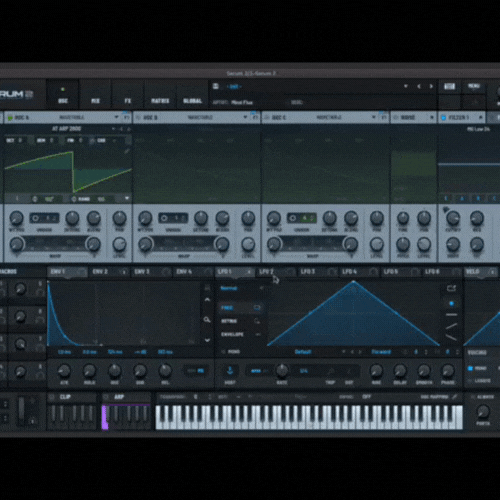Drawing Custom LFO Paths in Serum 2: Turning Modulation into Rhythm Design
Serum 2 expands its modulation engine with a new way to draw movement: Path Mode.
Instead of shaping a single waveform, you can now sketch motion across an X/Y field — where each axis becomes its own modulation source.
It’s not just about cycles anymore; it’s about designing how parameters interact over time.
For techno producers, this turns modulation into performance — rhythm, texture, and movement designed directly inside the synth.
“It’s not just modulation — it’s rhythm design.”
What’s New in Serum 2’s LFO System
Serum 1 let you draw LFO shapes freely along a timeline.
Serum 2 keeps that but adds Path Mode, a new two-dimensional modulation type that works differently from traditional LFO drawing.
Standard LFO Mode: uses editable curves and step drawing with smoothing and snapping for tempo-locked rhythm.
Path Mode: replaces the timeline with a 2-D field. You draw a motion path instead of waveform cycles.
Each axis (X and Y) outputs independent modulation signals, routable to any destination.
Rate and smoothing determine how quickly the motion travels across the path and how fluidly it interpolates between points.
Visual feedback shows the movement dot following your path in real time.
Where the regular LFO works like a rhythmic oscillator, Path Mode behaves more like a motion sequencer — continuous, spatial, and alive.
Why It’s Essential for Techno
Techno lives on movement — energy that shifts subtly bar to bar.
Path Mode brings that evolution inside Serum.
Instead of programming automation lanes, you can create relationships between parameters that move in sync or counter to each other.
Examples:
Filter and Resonance Interaction: X modulates cutoff, Y modulates resonance — one movement shapes both tone and intensity.
Stereo Depth and FX Balance: X pans delay feedback, Y moves reverb mix, creating living space.
Layered Modulation: Route Path X to oscillator detune and Path Y to distortion drive for pulsing, reactive bass tones.
Each patch becomes self-modulating, constantly shifting in ways that match your groove.
How to Use Path Mode
Path Mode might look abstract at first, but it’s built for intuition.
Instead of drawing waveforms, you’re sketching a journey — a line that moves through time and space, with each axis controlling a different parameter.
The beauty is that every curve, corner, or sweep becomes part of the modulation flow.
Whether you want gentle drift, rhythmic interplay, or tightly synced motion, Path Mode lets you design movement as naturally as drawing automation in your DAW — only now, it’s happening inside Serum.
Open Serum 2 and click on an LFO tab.
Change the mode from Standard to Path.
You’ll see an X/Y grid appear.Draw your path by dragging on the field.
The line you create defines how X and Y values change over time.Adjust the rate — faster rates trace the path quickly, slower ones drift gradually.
Set smoothing to control how sharply the motion follows your drawn path.
Assign outputs:
Path X → Filter Cutoff
Path Y → Reverb Size (for example)
Experiment with looping or one-shot modes for rhythmic vs evolving modulation.
Tip: Combine Path Mode with Chaos LFO modulation depth to make your path movement feel organic and never exactly repeat.
Creative Ideas
Once you’re comfortable drawing motion, think of Path Mode as a gesture system — your modulation literally sketches how energy flows in the patch.
Dual-Axis Groove: Use Path X for rhythmic filter sweeps and Path Y for per-beat reverb modulation.
Analog Drift: Small circular paths applied to pitch and pan recreate the slow instability of vintage gear.
Atmospheric Shimmer: Route Path X to delay feedback and Path Y to reverb mix — add Chaos for shifting ambience.
Morphing Pads: Large, looping paths across oscillator warp and filter drive keep textures evolving.
Each line you draw can become a repeating phrase of motion — the modulation becomes part of your groove.
Wrap-Up
Serum 2’s Path Mode changes how producers think about LFOs.
It replaces repetitive cycles with drawn motion — modulation that moves through space instead of looping over time.
For techno, it’s a powerful way to fuse rhythm and texture inside the patch itself.
“When modulation grooves, the track comes alive.”



